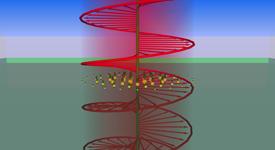

03/29/2021

© 2021 Satoshi Iihama
Helical light beams can induce electron spins at the interface of a magnetic and non-magnetic material, three AIMR researchers have discovered1. This effect could form the basis of light-driven magnetic memory devices that are much faster and have far lower power consumption than present memory devices.
Researchers are working on developing a new breed of devices that will combine the advantages of light and electricity. Such devices will realize rapid, low-energy information processing by using photonic integrated circuits, in which light is used to perform many of the functions currently realized electronically.
“Photonic integrated circuits are being developed for future fast and energy-efficient information processing by using light, because light is low loss and extremely fast,” says Satoshi Iihama of AIMR at Tohoku University. “Consequently, many researchers are trying to implement optics in electronic devices.”
Ideally, data would be stored in such devices by using light to switch the direction of magnetization in nanoscale magnets, but this has yet to be realized due to the weak interaction between light and magnetic materials.
One promising way to overcome this problem is to use helical laser beams to manipulate the magnetization in metallic ferromagnets. However, so far no-one has investigated the interface between a ferromagnetic film and a non-magnetic heavy metal film — a method that has been effective for controlling magnetization electrically.
Now, by investigating this system (see image), Iihama and two AIMR co-workers have found a new way to generate spins optically. They were able to generate spins at the interface of the two materials due to the optical equivalent of the Rashba–Edelstein effect — a phenomenon discovered in 1990 by which an electric current is converted into an accumulation of spin. The optical Rashba–Edelstein effect was proposed theoretically, but has not been demonstrated experimentally so far.
“We tried to observe the optical Rashba–Edelstein effect experimentally using the interface between a ferromagnet and a heavy metal, and we discovered that there exists a coupling between optical helicity and electron spins even at a nanoscale interface,” says Iihama. “This is the first time this has been demonstrated, and it came as a surprise to us.”
“This study could lead to energy-efficient photonic–magnetic memory devices, and it could also open up a new research field that combines nanophotonics and spintronics,” says Iihama. “As a next step toward realizing photonic-magnetic memory devices, we are planning to try to further increase the nanoscale photonic–spintronic coupling.”
This research highlight has been approved by the authors of the original article and all information and data contained within has been provided by said authors.